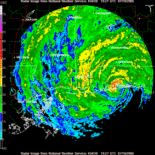Pensacola was Americas 1st settlement in 1559 but was destroyed by a hurricane...go figure
Pensacola was the first settlement of Europeans in what is now the United States. The area was first sighted by a European in 1513 by Spanish explorer Juan Ponce de Leon. Three years later, Don Diego Miruelo became the first European to sail into Pensacola Bay.
A settlement was founded in 1559 by Don Tristan de Luna and his party of about 1500 Spanish settlers. However, the settlement was destroyed by a major hurricane shortly afterwards, and was abandoned.
For this reason, many people instead regard St. Augustine, Florida as the first permanent European settlement in what would become the United States. The City of Pensacola, however, still occasionally refers to the area as "America's First Settlement" in advertisements and travel brochures.
The city and its bay were named after the Panzacola indians, a tribe that lived near the bay when the Spanish arrived. The name was changed to Pensacola to make it easier to pronounce for the Spanish. Despite the original settlement's destruction, the name was preserved and used when the area was re-settled during the 17th Century.
The area was first referred to as "Panzacola" in 1686. Previously, it was known as "Bahia Santa Maria de Filipina", as it was named so by Tristan de Luna when he founded the area's first settlement. "Panzacola" was affirmed as the area's name by a royal order of Spanish King Ferdinand VI in 1757.
The Spanish resettled Pensacola in 1698 under the direction of governor Andrés de Arriola. The French captured the settlement in 1719 and remained in control for three years. They burned the settlement on their retreat in 1722. The area was rebuilt, but ravaged by hurricanes in 1752 and 1761.
British Phase
At the close of the Seven Years' War (known in America as the French and Indian War) in 1763 the British took control of Pensacola. It is during the British occupation that the area began to prosper. Pensacola was made the capital of British West Florida and the town was laid out in its current form around the Seville Square district by surveyor and engineer Elias Durnford.
Spanish/American Phase
The Spanish recaptured Pensacola in 1781 and retained control (excepting three short-lived invasions by American General Andrew Jackson in 1813, 1814, and 1818) until 1821, when the Adams-Onís Treaty ceded all of Spanish Florida to the United States.
In 1825, the area for the Navy Yard was designated and Congress appropriated $6,000 for a lighthouse. The first permanent Protestant Christian congregation was established in 1827.
The Pensacola area is home to three historic U.S. forts, Fort Pickens, Fort Barrancas, and Fort McRee, as well as Barrancas National Cemetery. The city and Fort Barrancas were the site of the 1814 Battle of Pensacola. Fort Pickens was completed in 1834. It holds the distinction of being the only Southern fort not to be captured by the Confederacy in the American Civil War.
On 3 March 1845, Florida was admitted to the Union as the 27th state.
Confederate Phase
When Florida seceded from the Union on January 10th, 1861, remaining Union forces in the city evacuated to Fort Pickens. The Confederacy then held Pensacola until abandoning the city in May of 1862.
Florida was readmitted to the Union on 25 June 1868.
Other notable facts
From 1885 to 1887, the famous Apache Indian chief Geronimo was imprisoned in Fort Pickens, along with several of his warriors and their families. Fort Pickens is now a part of the Gulf Islands National Seashore, and as such, is administered by the United States Park Service.
Pensacola was the capital of Florida before Tallahassee became the capital.
Pensacola is home to a very large Jewish community, whose roots stretch back to the mid to late 1800s. The first Florida chapter of B'nai Brith was founded downtown in 1874, as well as the first temple, Beth-El, in 1876. Paula Ackerman, the first woman who performed rabbinical functions in the United States, was a Pensacola native and led services at Beth-El. Today, Pensacola has the second-largest concentration of Jewish people in the state, behind the South Florida metropolitan area.
Geography
Pensacola is located at 30°26'13" North, 87°12'33" West (30.436988, -87.209277).
According to the United States Census Bureau, the city has a total area of 102.7 km² (39.7 mi²). 58.8 km² (22.7 mi²) of it is land and 43.9 km² (17.0 mi²) of it is water. The total area is 42.77% water.
Hurricanes
Pensacola's location on the Florida Panhandle makes it vulnerable to hurricanes. Major hurricanes which have made landfall at or near Pensacola include Hurricane Juan (1985), Hurricane Opal (1995), and Hurricane Ivan (2004).
The Pensacola area was devastated by Hurricane Ivan. The hurricane either damaged or destroyed a large number of homes and businesses. Particularly hard-hit were the areas around Perdido Bay and Pensacola Beach. In addition, many of the area's bridges sustained structural damage. The hurricane disrupted public schools in Escambia County for nearly a month.



